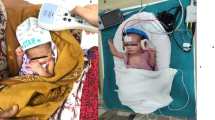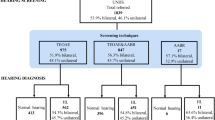Abstract
Auditory neuropathy spectrum disorder (ANSD) is a particular kind of hearing disorder characterised by normal outer hair cell function and abnormal or absent auditory brain stem responses. Little data are available regarding the prevalence of this condition in healthy newborns. We performed a retrospective medical records review of 791 referrals from universal neonatal hearing screening (UNHS) at a well-baby clinic to investigate the prevalence of ANSD. Hearing screening was performed by automated auditory brain stem response (ABR) testing. A diagnosis of ANSD was established when ABR tracings were absent in the presence of otoacoustic emissions and/or a cochlear microphonic. Amongst 201 infants with confirmed congenital hearing loss, 13 infants were diagnosed with ANSD. The condition was unilateral in six and bilateral in seven infants. A risk factor for hearing loss could be identified in three infants. Abnormalities on magnetic resonance imaging were found in six infants; five of them had cochlear nerve deficiency.
Conclusion: The prevalence of ANSD was 6.5 % amongst well babies with confirmed congenital hearing loss identified through UNHS. The estimated incidence of ANSD in our population of newborns at the well-baby clinic was 0.09/1000 live births. Magnetic resonance revealed an underlying anatomical abnormality in about half of the patients.
What is known: • Auditory neuropathy dyssynchrony spectrum disorder (ANSD) is a particular form of hearing loss, mostly encountered in neonatal intensive care unit (NICU) graduates. • Little data are available on the prevalence and risk factors for ANSD in healthy newborns. |
What is new: • The estimated prevalence of ANSD in healthy newborns is 0.09/1000 live births. • In about half of the healthy newborns with ANSD, a structural abnormality was detected on magnetic resonance imaging of the posterior fossa/brain. |


Similar content being viewed by others
Abbreviations
- AABR:
-
Automatic ABR
- ABR:
-
Auditory brain stem responses
- ASSR:
-
Auditory steady state responses
- CM:
-
Cochlear microphonic
- CMV:
-
Cytomegalovirus
- CND:
-
Cochlear nerve deficiency
- ENT:
-
Ear-nose-throat
- HL:
-
Hearing loss
- MRI:
-
Magnetic resonance imaging
- nHL:
-
Normal hearing level
- NICU:
-
Neonatal intensive care unit
- TOAEs:
-
Transient evoked otoacoustic emissions
- UNHS:
-
Universal neonatal hearing screening
References
American Academy of Pediatrics, Joint Committee on Infant Hearing (2007) Year 2007 position statement: principles and guidelines for early hearing detection and intervention programs. Pediatrics 120:898–921. doi:10.1542/peds.2007-2333
Attias J, Raveh E (2007) Transient deafness in young candidates for cochlear implants. Audiol Neurotol 12:325–333. doi:10.1159/000103271
Berg AL, Spitzer JB, Towers HM, Bartosiewicz C, Diamond BE (2005) Newborn hearing screening in the NICU: profile of failed auditory brainstem response/passed otoacoustic emission. Pediatrics 116:933–938. doi:10.1542/peds.2004-2806
Berlin CI, Hood LJ, Morlet T, Wilensky D, Li L, Mattingly KR, Taylor-Jeanfreau J, Keats BJ, John PS, Montgomery E, Shallop JK, Russell BA, Frisch SA (2010) Multi-site diagnosis and management of 260 patients with auditory neuropathy/dys-synchrony (auditory neuropathy spectrum disorder). Int J Audiol 49:30–43. doi:10.3109/14992020903160892
Beutner D, Foerst A, Lang-Roth R, von Wedel H, Walger M (2007) Risk factors for auditory neuropathy/auditory synaptopathy. ORL J Otorhinolaryngol Relat Spec 69:239–244. doi:10.1159/000101545
Boudewyns AN, Declau F, De Ridder D, Parizel PM, van den Ende J, Van de Heyning PH (2008) Case report: “auditory neuropathy” in a newborn caused by a cerebellopontine angle arachnoid cyst. Int J Pediatr Otorhinolaryngol 72:905–909. doi:10.1016/j.ijporl.2008.02.003
Boudewyns A, Declau F, Van den Ende J, Van Kerschaver E, Dirckx S, Hofkens-Van Den Brandt A, Van de Heyning P (2011) Otitis media with effusion: an underestimated cause of hearing loss in infants. Otol Neurotol 32:799–804. doi:10.1097/MAO.0b013e31821b0d07
Buchman CA, Roush PA, Teagle HF, Brown CJ, Zdanski CJ, Grose JH (2006) Auditory neuropathy characteristics in children with cochlear nerve deficiency. Ear Hear 27:399–408. doi:10.1097/01.aud.0000224100.30525.ab
Declau F, Boudewyns A, Van den Ende J, Peeters A, van den Heyning P (2008) Etiologic and audiologic evaluations after universal neonatal hearing screening: analysis of 170 referred neonates. Pediatrics 121:1119–1126. doi:10.1542/peds.2007-1479
Declau F, Boudewyns A, Van den Ende J, van de Heyning P (2013) Auditory neuropathy: a challenge for diagnosis and treatment. B-Ent Suppl 21:65–79
Dowley AC, Whitehouse WP, Mason SM, Cope Y, Grant J, Gibbin KP (2009) Auditory neuropathy: unexpectedly common in a screened newborn population. Dev Med Child Neurol 51:642–646. doi:10.1111/j.1469-8749.2009.03298.x
King AM, Purdy SC, Dillon H, Sharma M, Pearce W (2005) Australian hearing protocols for the audiological management of infants who have auditory neuropathy. Aust N Z J Audiol 27:69–77
Kirkim G, Serbetcioglu B, Erdag TK, Ceryan K (2008) The frequency of auditory neuropathy detected by universal newborn hearing screening program. Int J Pediatr Otorhinolaryngol 72:1461–1469. doi:10.1016/j.ijporl.2008.06.010
Korver AM, van Zanten GA, Meuwese-Jongejeugd A, van Straaten HL, Oudesluys-Murphy AM (2012) Auditory neuropathy in a low-risk population: a review of the literature. Int J Pediatr Otorhinolaryngol 76:1708–1711. doi:10.1016/j.ijporl.2012.08.009
Lin HC, Shu MT, Lee KS, Lin HY, Lin G (2007) Reducing false positives in newborn hearing screening program: how and why. Otol Neurotol 28:788–792
Madden C, Rutter M, Hilbert L, Greinwald JH Jr, Choo DI (2002) Clinical and audiological features in auditory neuropathy. Arch Otolaryngol Head Neck Surg 128:1026–1030
Ngo RY, Tan HK, Balakrishnan A, Lim SB, Lazaroo DT (2006) Auditory neuropathy/auditory dys-synchrony detected by universal newborn hearing screening. Int J Pediatr Otorhinolaryngol 70:1299–1306. doi:10.1016/j.ijporl.2005.12.004
Psarommatis I, Riga M, Douros K, Koltsidopoulos P, Douniadakis D, Kapetanakis I, Apostolopoulos N (2006) Transient infantile auditory neuropathy and its clinical implications. Int J Pediatr Otorhinolaryngol 70:1629–1637. doi:10.1016/j.ijporl.2006.05.005
Rance G, Beer DE, Cone-Wesson B, Shepherd RK, Dowell RC, King AM, Rickards FW, Clark GM (1999) Clinical findings for a group of infants and young children with auditory neuropathy. Ear Hear 20:238–252
Roche JP, Huang BY, Castillo M, Bassim MK, Adunka OF, Buchman CA (2010) Imaging characteristics of children with auditory neuropathy spectrum disorder. Otol Neurotol 31:780–788
Rodriguez-Ballesteros M, Reynoso R, Olarte M, Villamar M, Morera C, Santarelli R, Arslan E, Meda C, Curet C, Volter C, Sainz-Quevedo M, Castorina P, Ambrosetti U, Berrettini S, Frei K, Tedin S, Smith J, Cruz Tapia M, Cavalle L, Gelvez N, Primignani P, Gomez-Rosas E, Martin M, Moreno-Pelayo MA, Tamayo M, Moreno-Barral J, Moreno F, del Castillo I (2008) A multicenter study on the prevalence and spectrum of mutations in the otoferlin gene (OTOF) in subjects with nonsyndromic hearing impairment and auditory neuropathy. Hum Mutat 29:823–831. doi:10.1002/humu.20708
Saluja S, Agarwal A, Kler N, Amin S (2010) Auditory neuropathy spectrum disorder in late preterm and term infants with severe jaundice. Int J Pediatr Otorhinolaryngol 74:1292–1297. doi:10.1016/j.ijporl.2010.08.007
Sininger Y (2004) Overview of auditory neuropathy. Audiology Online, July 8
Starr APTKR (2001) Pathophysiology of auditory neuropathy. In: Starr A, Sininger Y (eds) Auditory neuropathy: a new perspective on hearing disorders. Singular Thomson Learning, San Diego, pp 1–15
Acknowledgments
The authors would like to thank Luc Stappaerts from Kind and Gezin who provided the data on the UNHS screening for Flanders.
Author’s contribution
All authors contributed to data collection, interpretation of the data and preparation of the manuscript.
Author information
Authors and Affiliations
Corresponding author
Ethics declarations
Funding
None of the authors received any financial support or funding for the present study.
Conflict of interest
An Boudewyns declares that she has no conflict of interest.
Frank Declau declares that he has no conflict of interest.
Jenneke van den Ende declares that she has no conflict of interest.
Anouk Hofkens declares that she has no conflict of interest.
Sara Dirckx declares that she has no conflict of interest.
Paul van de Heyning declares that he has no conflict of interest.
Ethical approval
The study was performed in accordance with the ethical standards of the institutional research committee and with the 1964 Helsinki declaration and its later amendments or comparable ethical standards.
Informed consent
Informed consent was obtained from the caregivers of all individual infants included in the study.
Additional information
Communicated by Peter de Winter
Appendix: Cochlear microphonic
Appendix: Cochlear microphonic
The cochlear microphonic is a preneural response from the cochlear outer hair cells. The presence of a cochlear microphonic at or below a sound level that does not evoke a recordable ABR is an indication for ANSD. The cochlear microphonic is a more robust criterion for the diagnosis of ANSD compared to transient evoked otoacoustic emissions because these may disappear with time or may be absent in cases where there is also a conductive component to the hearing loss (such as with middle ear effusion).
The recommended method to detect a CM is the use of separate, replicated runs of condensation and rarefaction polarity at a stimulus level of 80 dB nHL.
A CM is considered present when a waveform appears in the first few milliseconds of the tracing and is the only part of the waveform that reverses polarity from rarefaction to condensation. A control trial is then performed with the sound tube of the insert phone clamped to rule out transducer artefacts.
An example of a cochlear microphonic is provided below Fig. 3. More detailed information may be found at Lightfoot G (ed). 2011. Guidelines for cochlear microphonic testing. NHSP Clinical Group (http://www.thebsa.org.uk/wp-content/uploads/2015/02/CM_Guidance_v2_2109111.pdf).
An example of an ABR tracing for the right ear, illustrating a cochlear microphonic. Using alternating click stimuli at intensities of 80 and 70 dB nHL, no ABR tracing is present (red line). However, using runs of condensation and rarefaction polarity at the same stimulus intensities reveals the presence of a cochlear microphonic (black arrow) appearing after 1 ms
Rights and permissions
About this article
Cite this article
Boudewyns, A., Declau, F., van den Ende, J. et al. Auditory neuropathy spectrum disorder (ANSD) in referrals from neonatal hearing screening at a well-baby clinic. Eur J Pediatr 175, 993–1000 (2016). https://doi.org/10.1007/s00431-016-2735-5
Received:
Revised:
Accepted:
Published:
Issue Date:
DOI: https://doi.org/10.1007/s00431-016-2735-5





